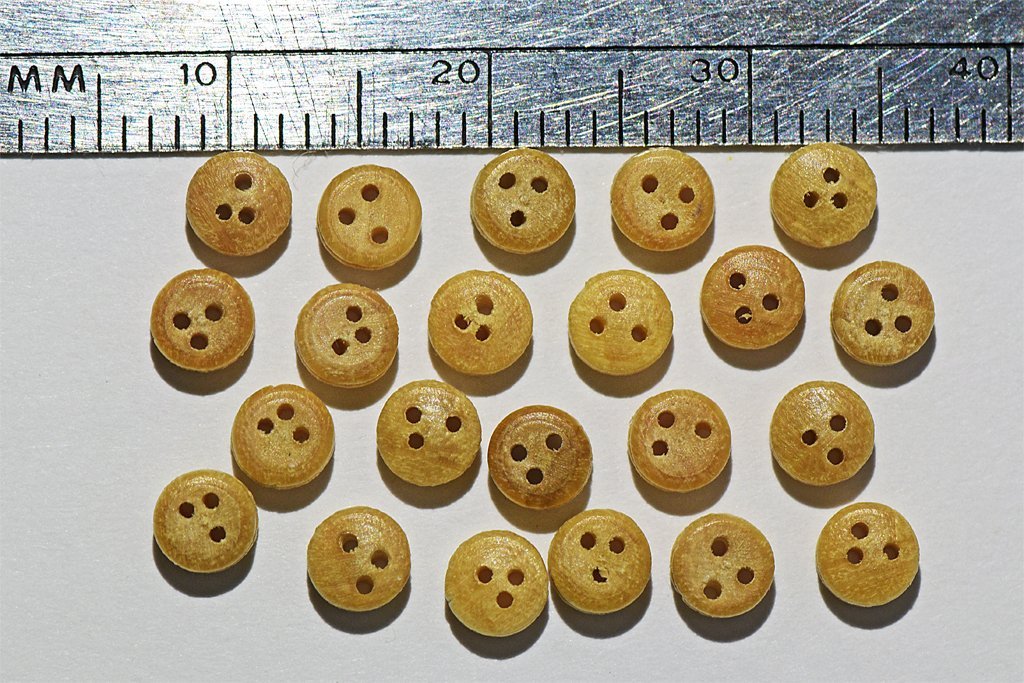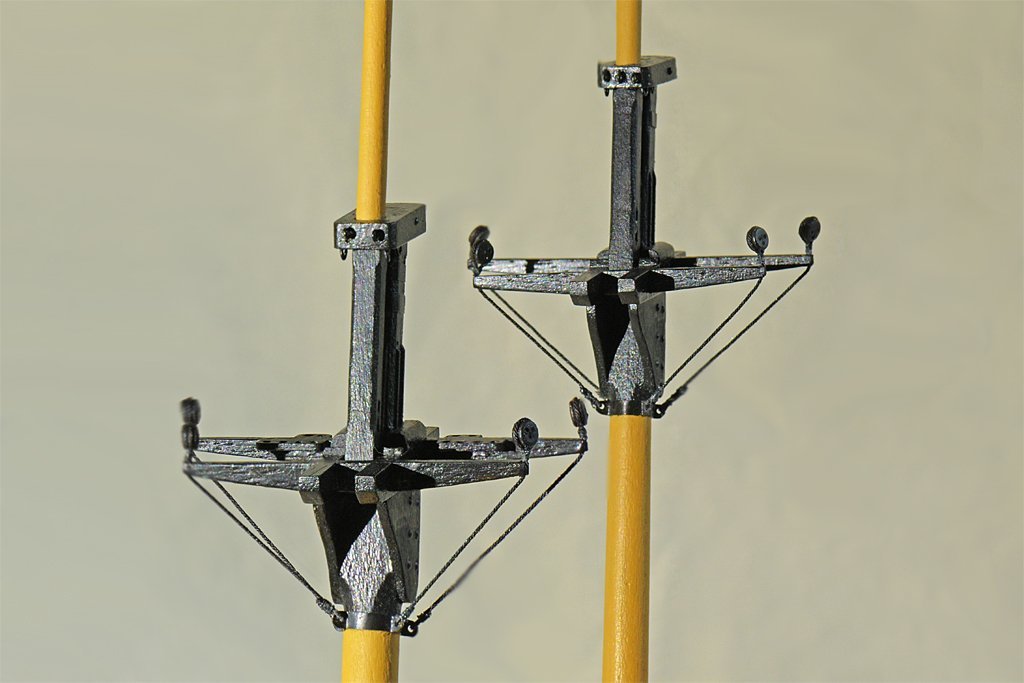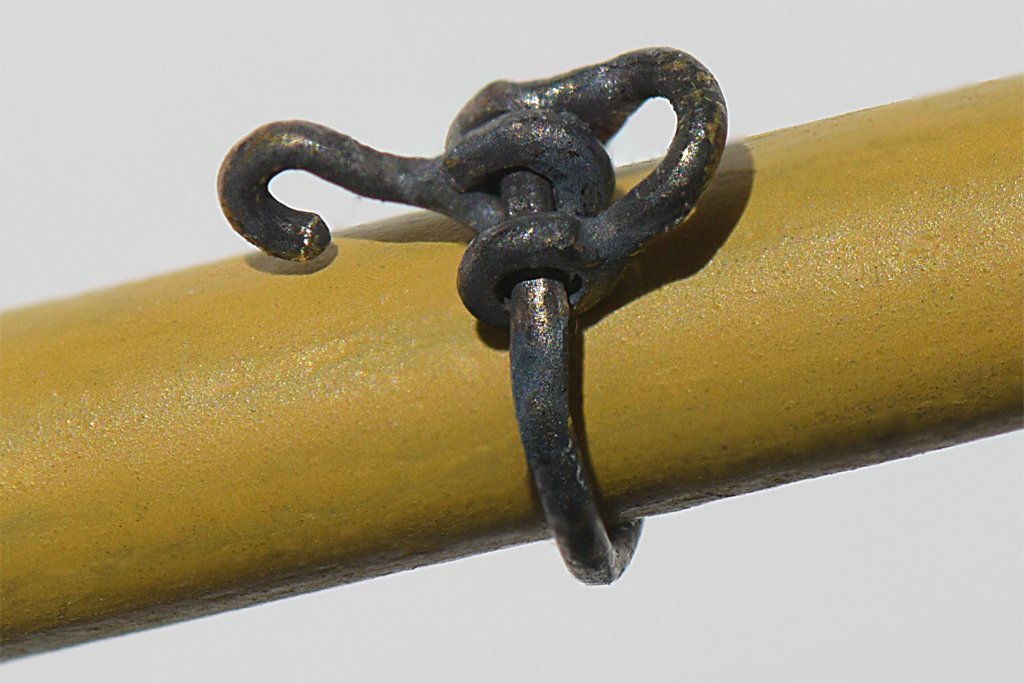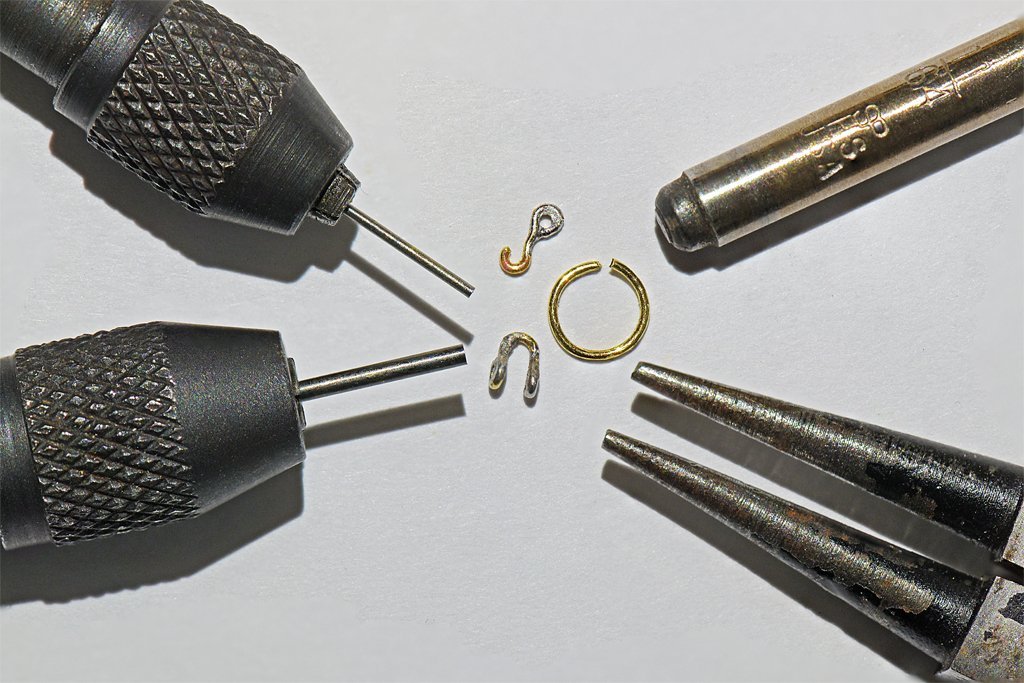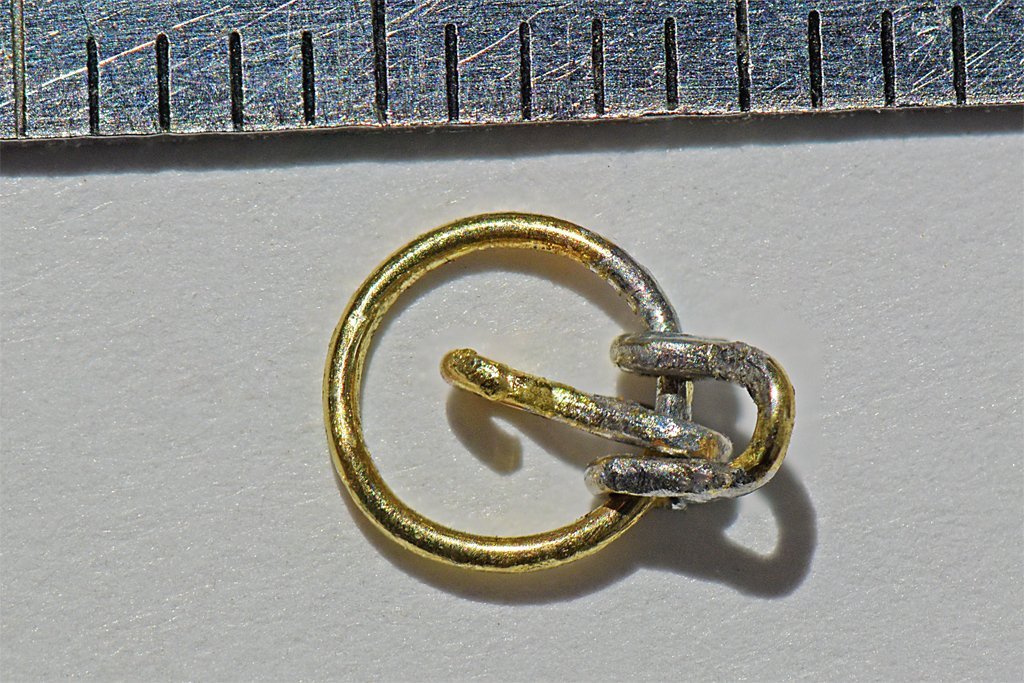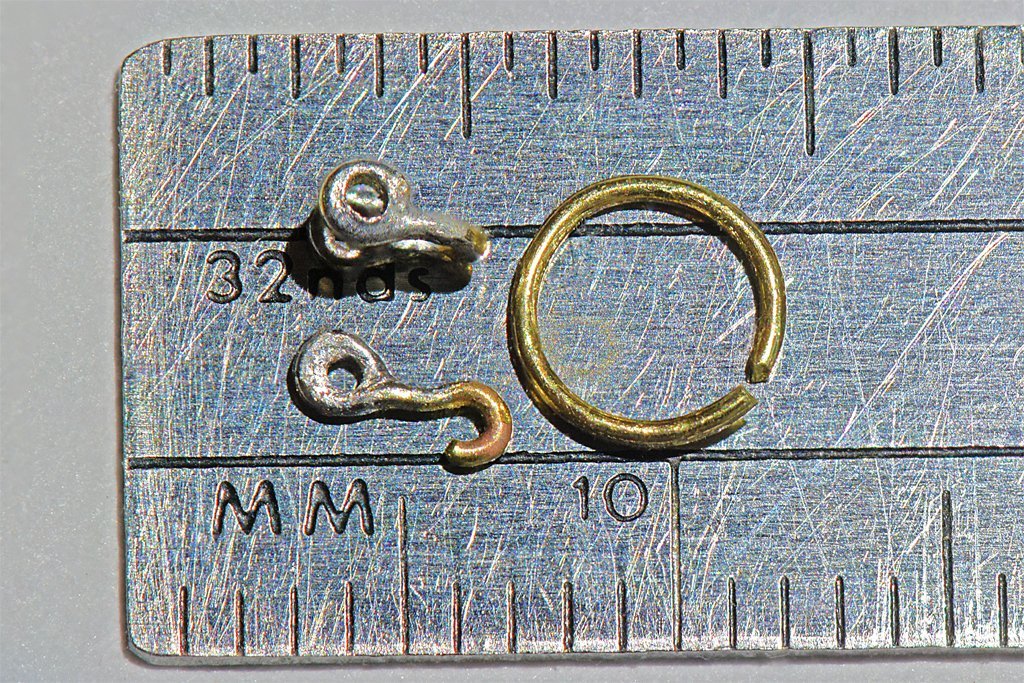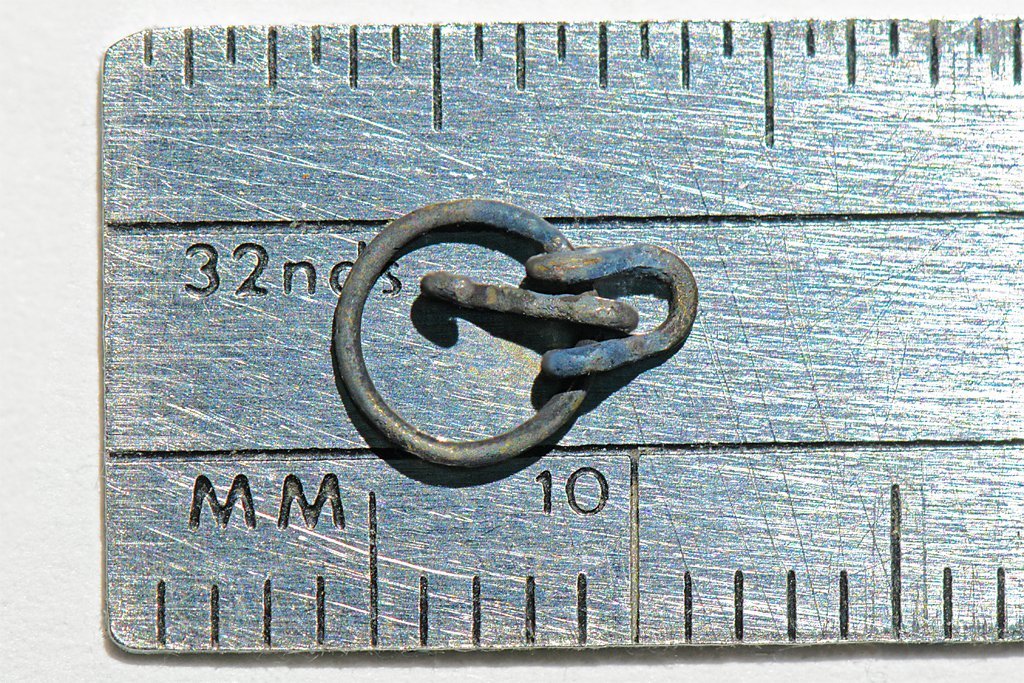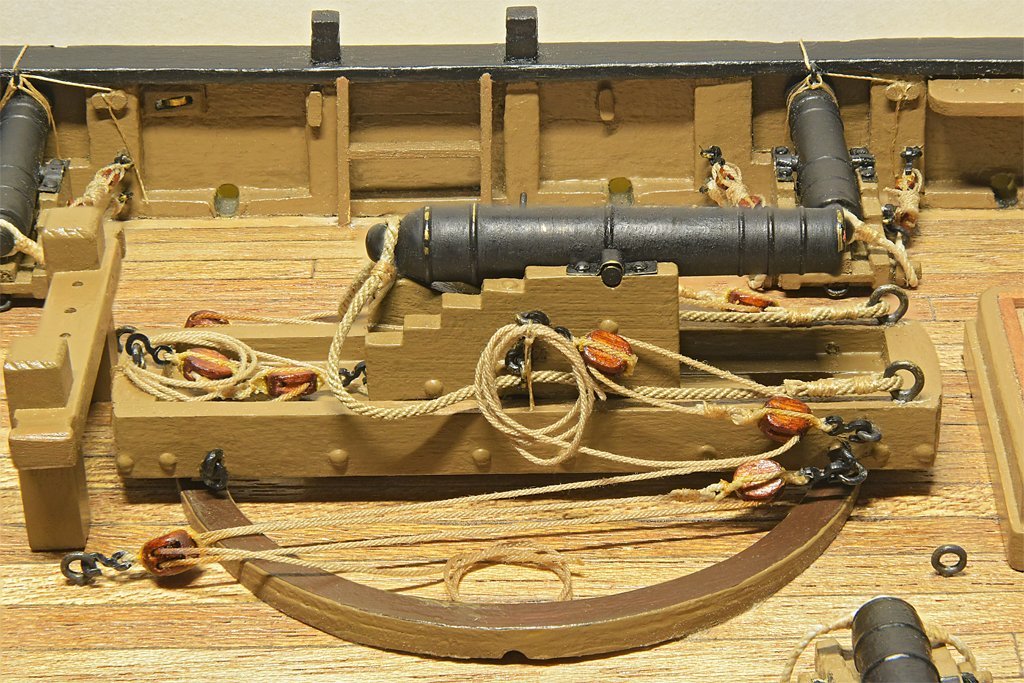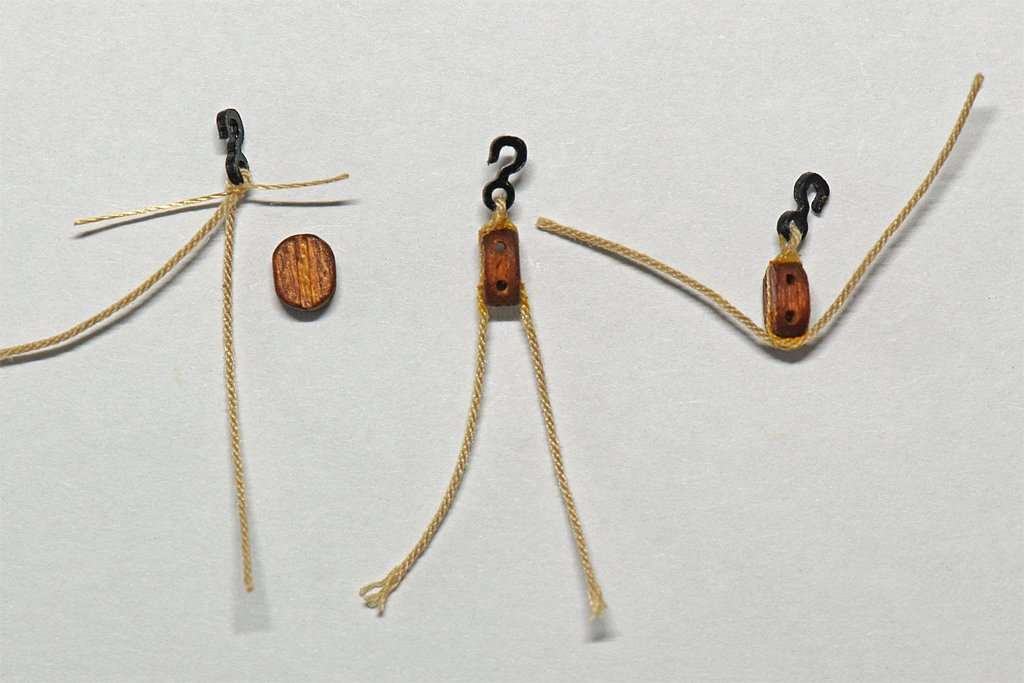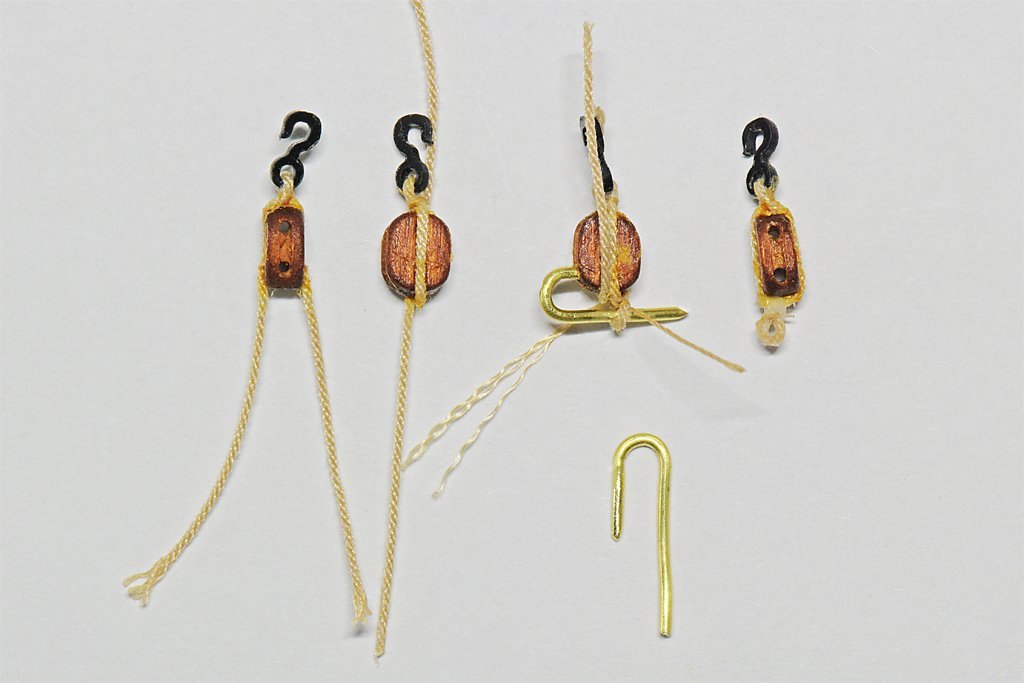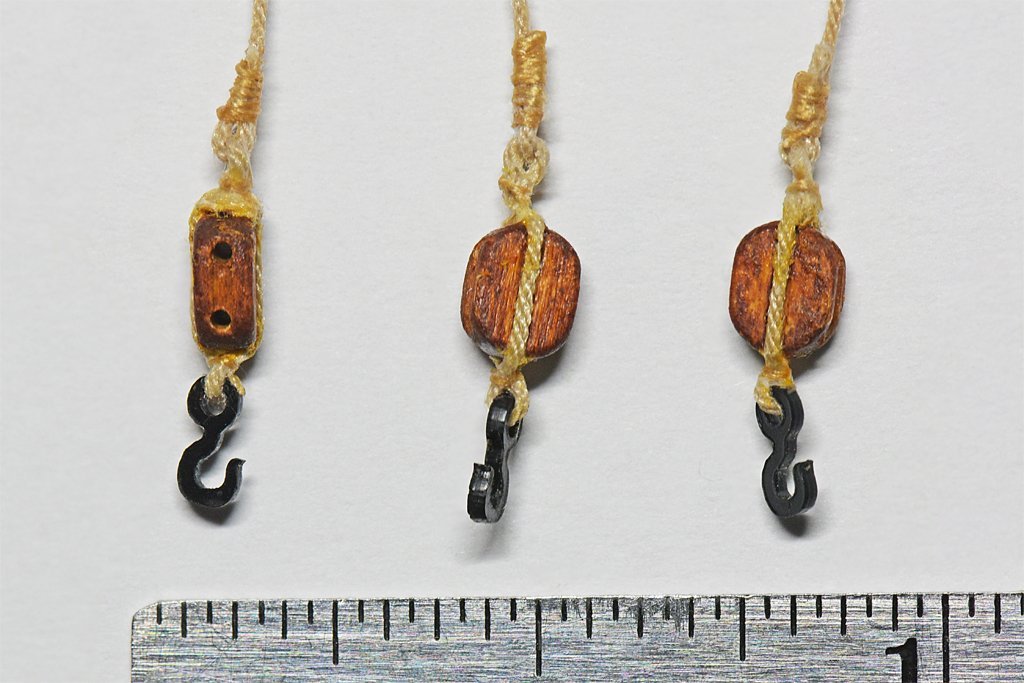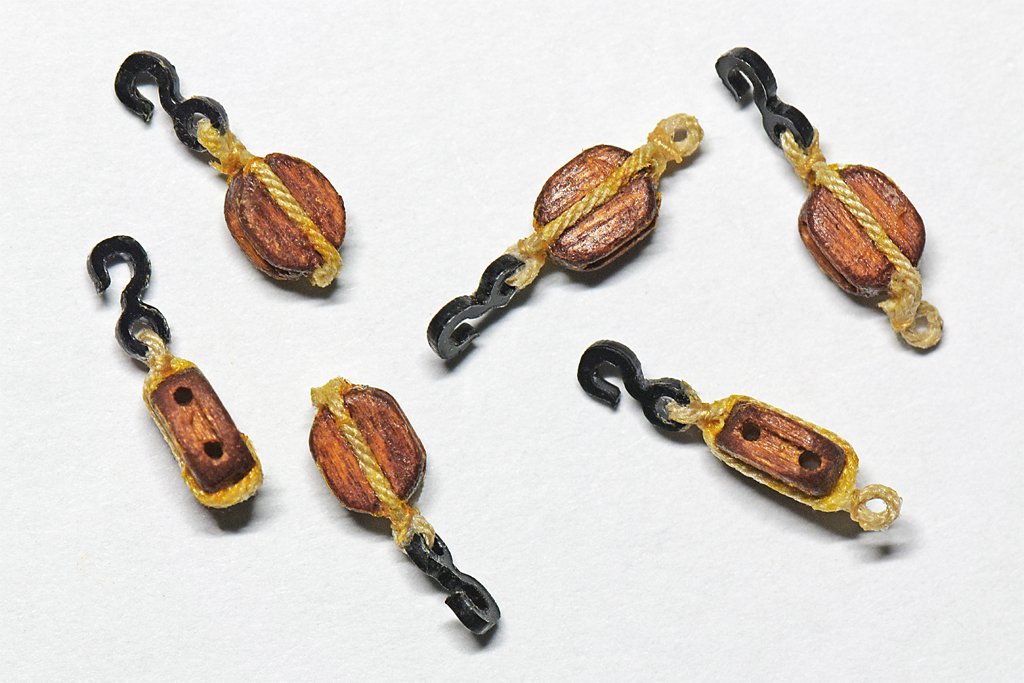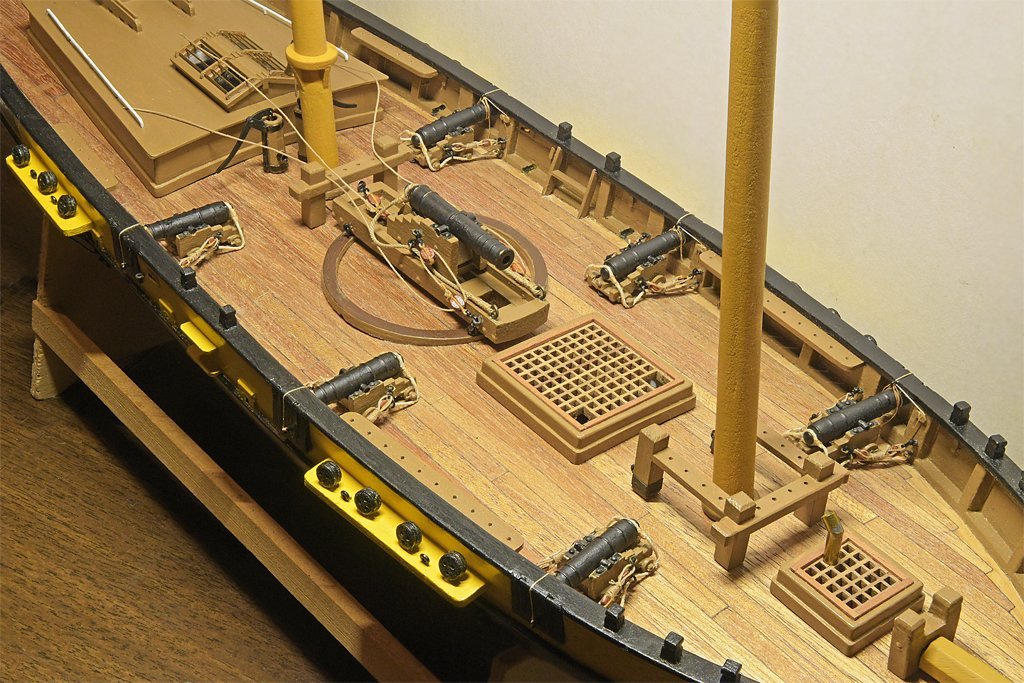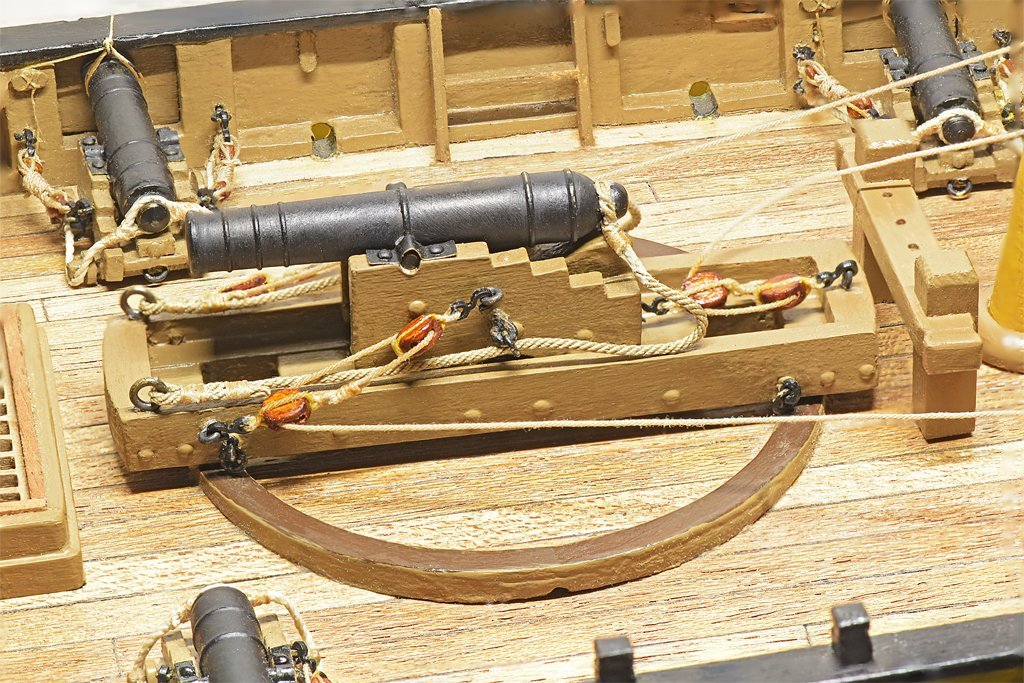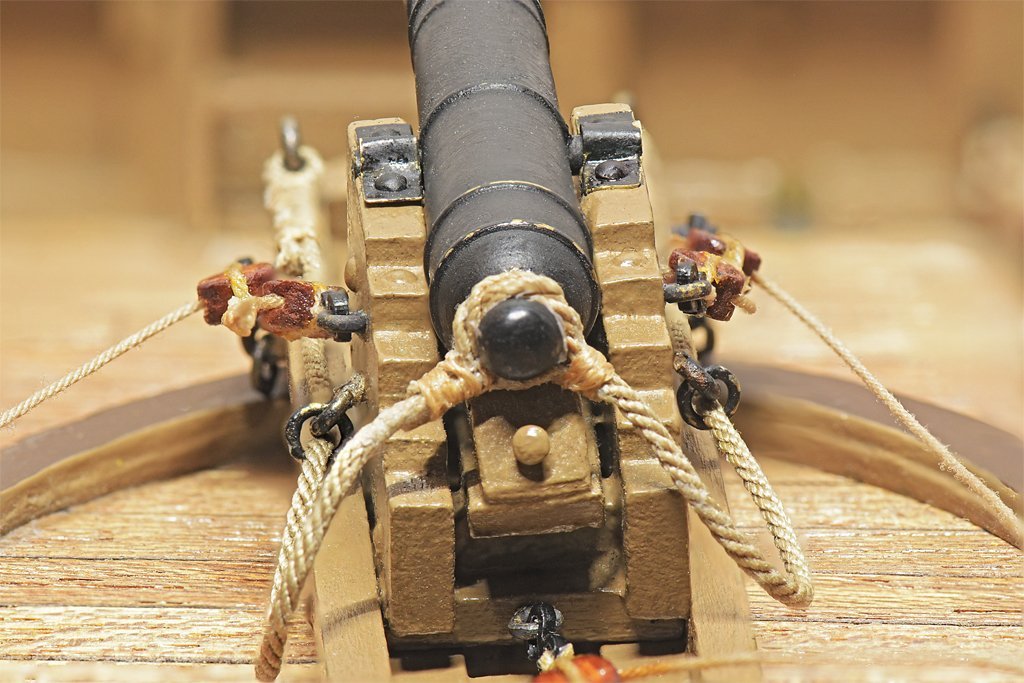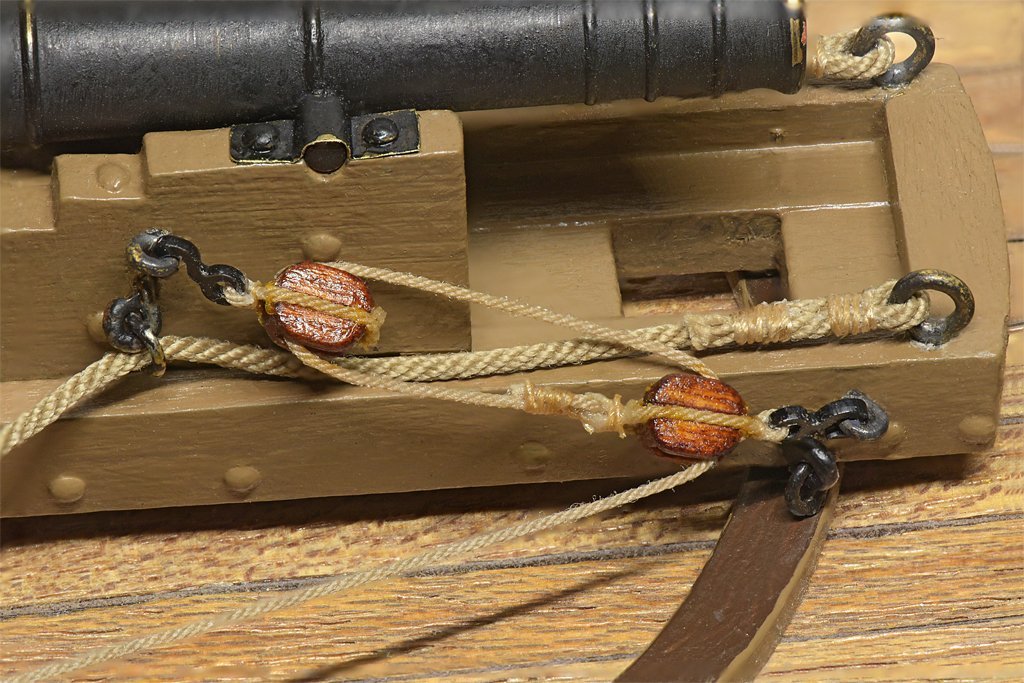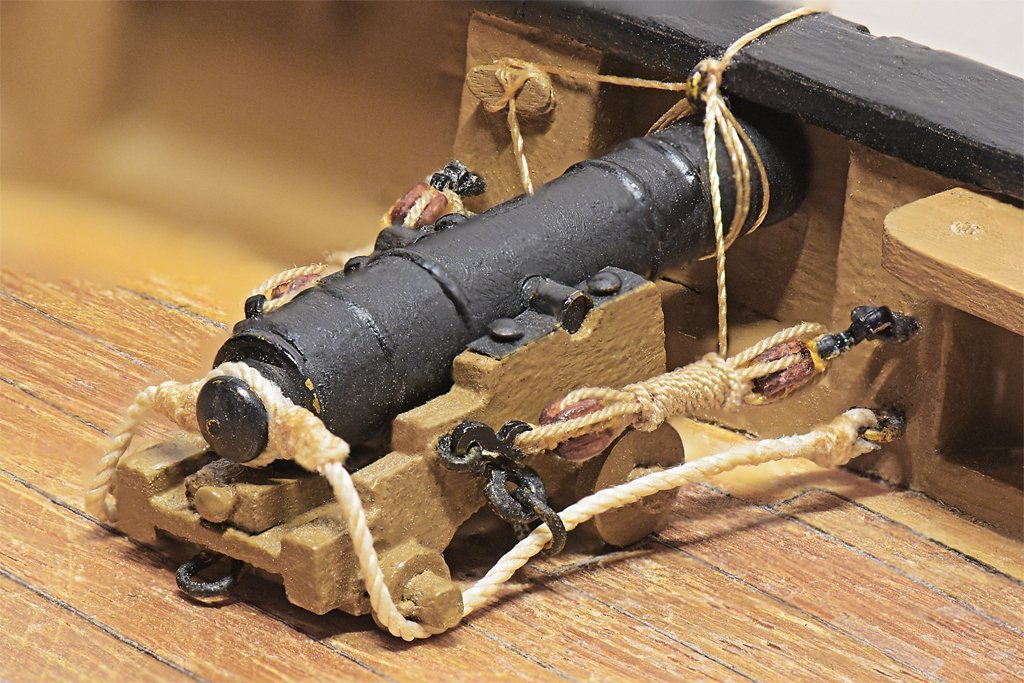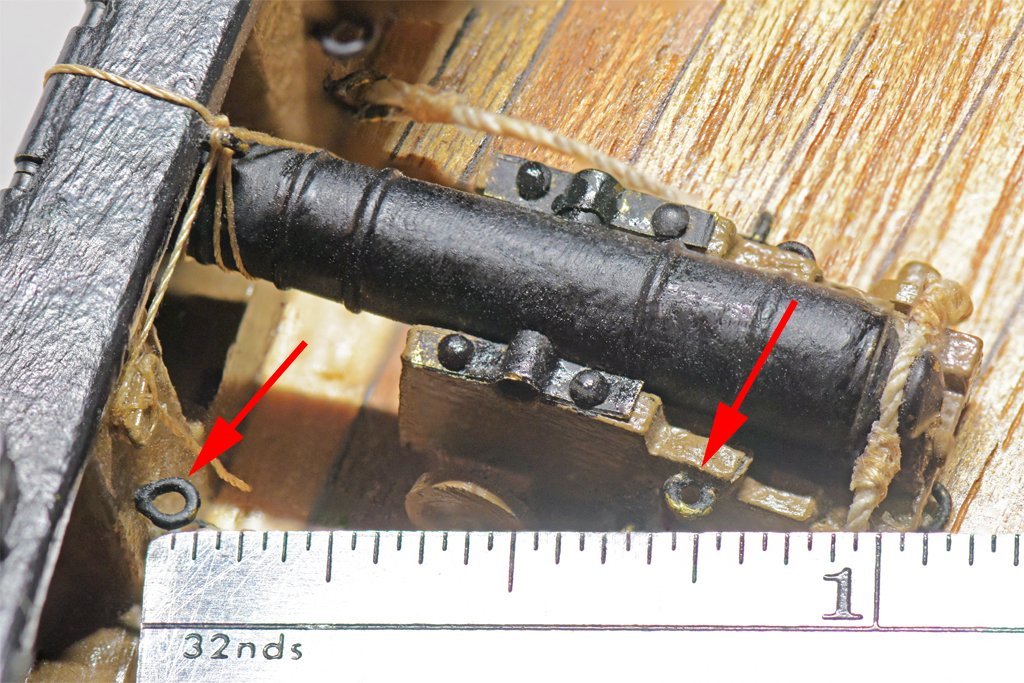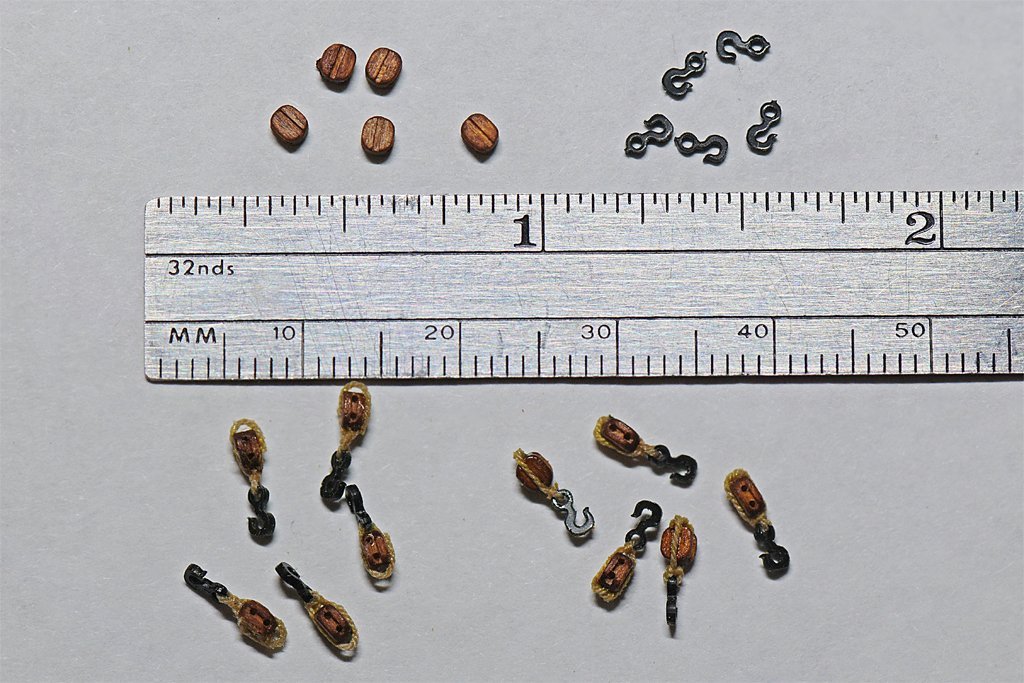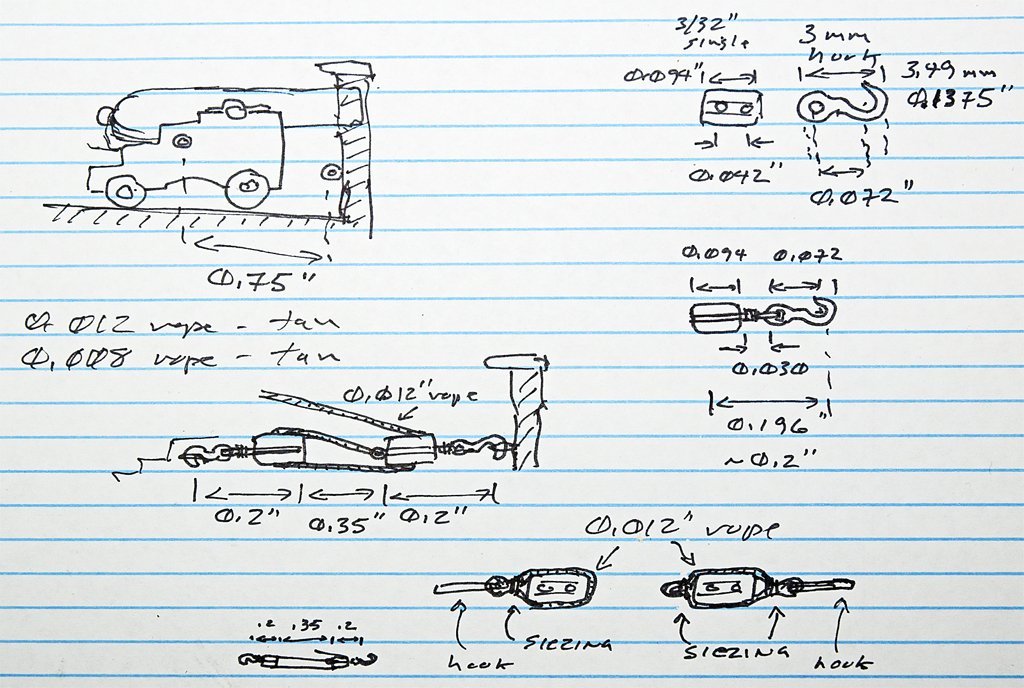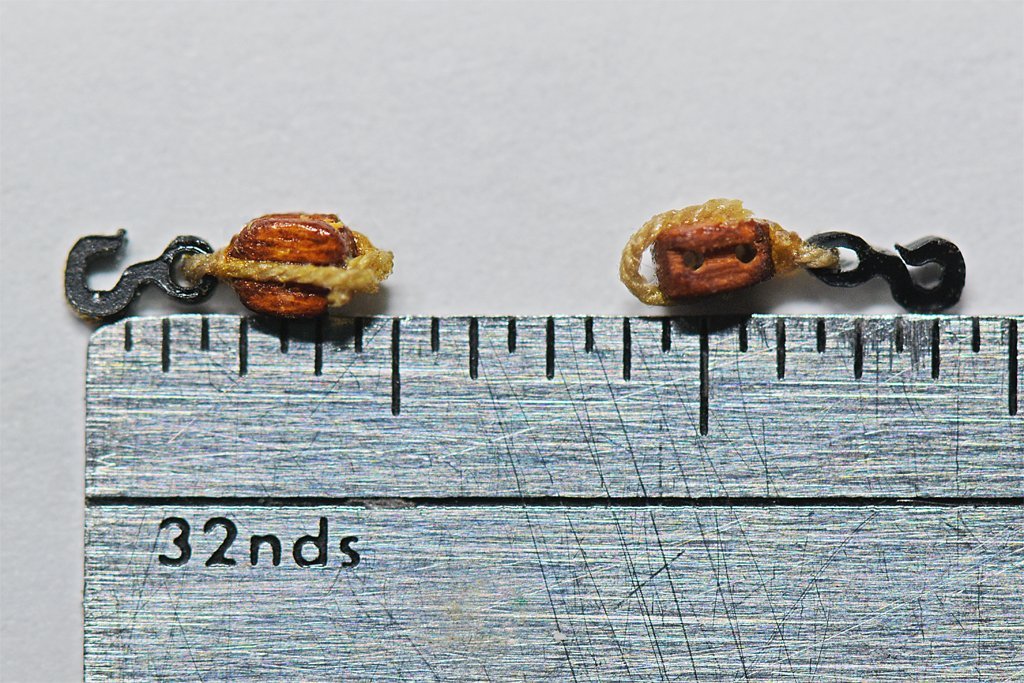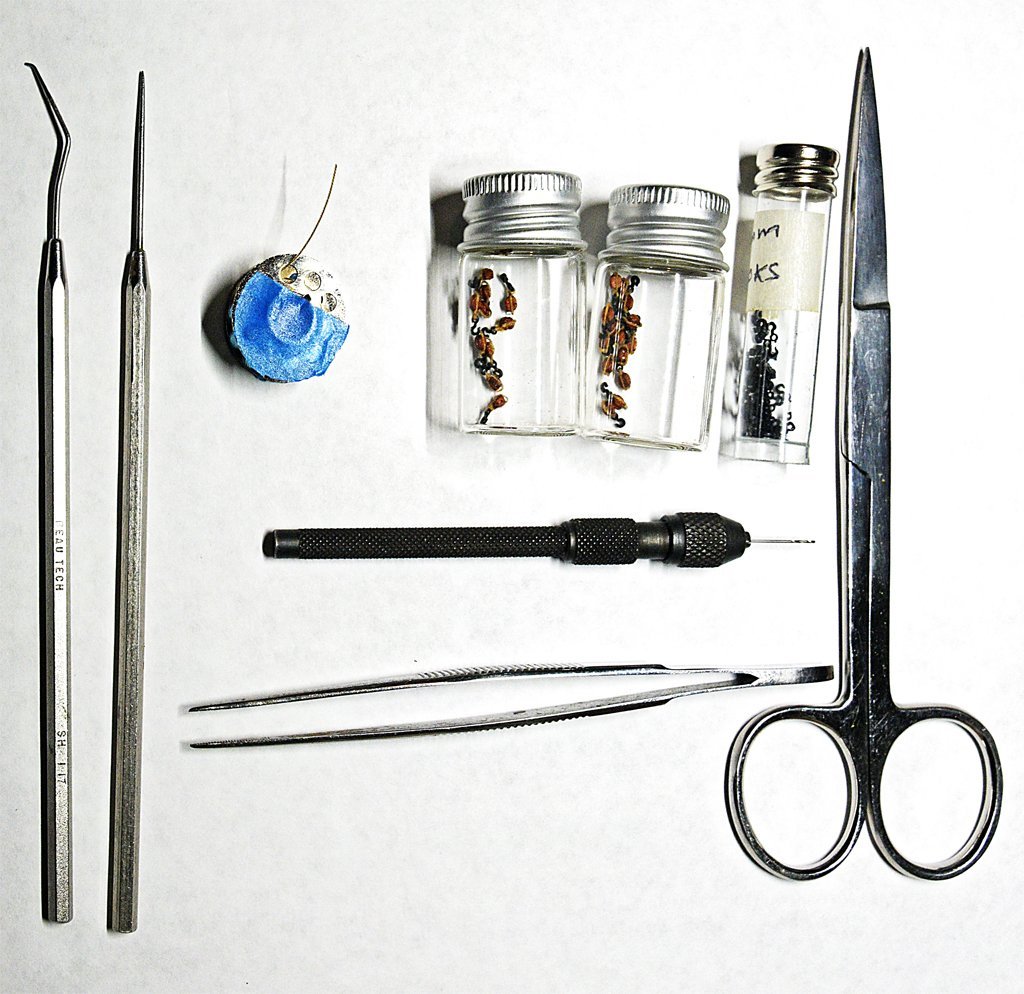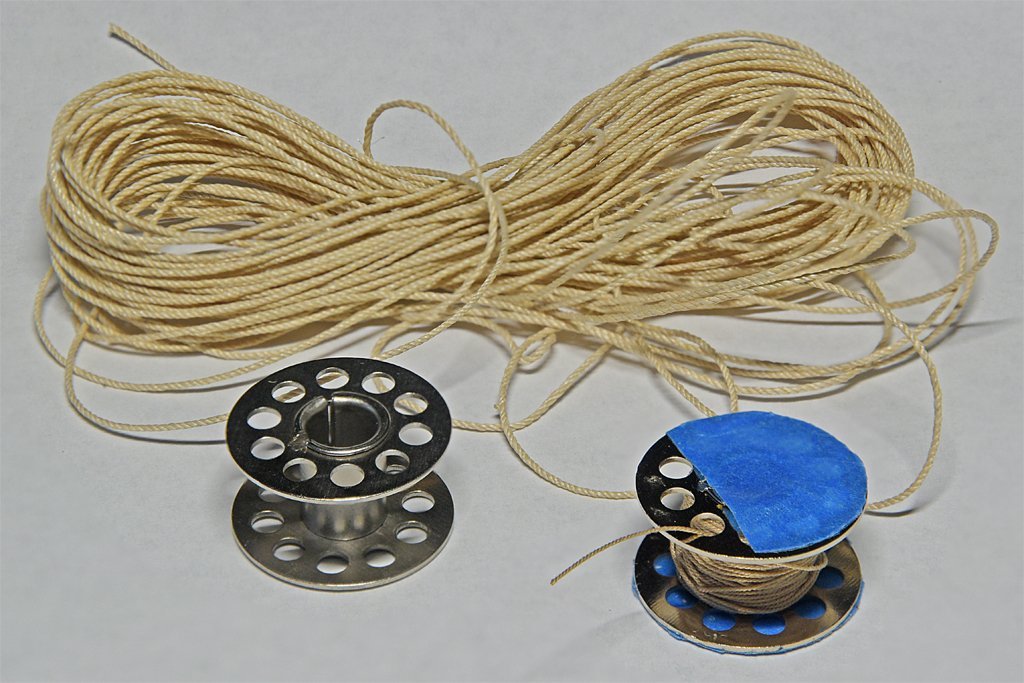-
Posts
2,452 -
Joined
-
Last visited
Content Type
Profiles
Forums
Gallery
Events
Everything posted by Dr PR
-

Pandora 1831 Brigantine Rigging and Masting
Dr PR replied to michaelpsutton2's topic in Masting, rigging and sails
Michael, I am not familiar with this ship, but here are some observations. 1. The fore gaff would probably have jaws around the mast. This allows the gaff and sail to be lowered. If it was mounted on a fixed swivel the gaff could not be lowered. This was common on large steel masted ships of the late 1800s, but not on the smaller vessels of the 1700s and early 1800s. The clue here would be a throat halliard connected to the gaff at the jaws. This would only be used to lower a gaff with jaws. I can't tell from the drawing if there is one. 2. The staysail could be flying. Underhill's Sailing Ship Rigs and Rigging (page 93) calls this the main topgallant staysail because it connects to the upper top. If it was not laced to the stay that would allow it to be lowered to the deck without sending anyone aloft. The main gaff topsail is rigged this way, and the fore royal spar was almost certainly rigged this way too. For that matter, the fore topgallant spar could be rigged to be lowered and raised from the deck. This allowed rapid changes of sail and reduction of weight up high. This was important on ships like this that had a vary large sail area relative to the displacement. They were prone to being blown over and capsizing in strong winds. There are quite a few historical accounts of this happening. 3. The foot of the main gaff sail (main sail) is not laced to the boom (on many vessels it was). It is "loose footed" with attachments to the boom only at the tack and clew. The fore gaff sail is loose footed and boomless. The loose footed sails could be reefed very quickly with brails. 4. Interesting that you call this a brigantine (hermaphrodite brig). Brigantines normally would not have a gaff foresail. It looks like a topsail schooner. However, the diagram does show faint outlines of two more triangular sails (middle staysail and main staysail) between the main mast and fore mast, and that is characteristic of a brigantine. So sometimes the vessel could be flying a schooner rig and the brigantine rig at other times. The distinction between a brigantine and topsail schooner is somewhat vague because some vessels could be both. -

18-Pounder Pivot Gun
Dr PR replied to AndyHall's topic in CAD and 3D Modelling/Drafting Plans with Software
Here are a couple of links to another pivot gun model based mainly on Chapelle's drawings. The cannon is kit material and not really to scale. The rest of the gun is. https://modelshipworld.com/topic/19611-albatros-by-dr-pr-mantua-scale-148-revenue-cutter-kitbash-about-1815/?do=findComment&comment=1003991 https://modelshipworld.com/topic/19611-albatros-by-dr-pr-mantua-scale-148-revenue-cutter-kitbash-about-1815/?do=findComment&comment=1004278 -
Gregory, It was plain tap water. Several other modelers have recommended diluting the Brass Black 50:50 with water to avoid excess flaking. And I found 5 minutes was long enough to blacken brass and tin/lead solder. Then there still is some black that will rub off the parts, but not much. Some people "pickle" the parts in warm Sparex #2 (sodium bisulfate) instead of vinegar to give the parts some "tooth." That might result in a more uniform finish, but I haven't tried that yet (I do have a package of Sparex on hand).
-
I have been preparing for rigging the masts and bowsprit, finishing details like cleats for the anchor rigging and such. Part of the job is to go back through my drawings to determine rope and block sizes for all the rigging. I started with the futtock shrouds on the mast tops. These have deadeyes at the ends of the crosstrees and ropes that lead down to the futtock necklaces around the mast below the cheeks. I wanted to use deadeyes that were smaller than the 5 mm parts I used on the channels. I looked around and found some Amati 3 mm boxwood deadeyes. These turned out to be 3.4 mm diameter, but this is good enough. I plan to use these at a dozen or more places where there are lines and stays that require periodic retensioning, so I ordered two bags of 20. That was a good thing, because there were no two pieces alike! Some have holes that are not symmetrically placed, and in some the holes are absurdly close together. Looks like they were drilled by hand! I was able to pick out 16 that were reasonably symmetrical and close enough to be used together for the shrouds. Maybe I can find enough pairs that are similar enough to finish the nine lines on the bowsprit. **** I am also working on attaching the blocks and deadeyes for the bowsprit assembly before it is attached to the hull. First up on that job was making the traveller for the flying jib stay. I consulted Lees, Marquardt and Lever to determine the size and type of traveller suitable for a small vessel. The ring diameter should be 1 1/4 times the diameter of the jib boom, and the wire should be between 0.013" (0.33 mm) and 0.026" (0.66 mm) at 1:48 scale. The jib boom is 0.14" (3.56 mm) diameter at the bowsprit cap, so the traveller ring should be about 0.175" (4.45 mm) inside diameter. I decided to use 0.020" (0.5 mm) hard brass rod for the ring, shackle and hook. This stuff is pretty small, and the shackle was something of a challenge. I used a 0.024" (0.6 mm) drill bit inserted into a pin vise with the shaft sticking out as a mandrel for shaping the eyes on the shackle and hook. A 0.044" (1.1 mm) bit in another pin vise was the mandrel for forming the "U" of the shackle. A 11/64" (0.172 ", 4.4 mm) drill bit was the mandrel for shaping the traveller ring. I used chain nosed pliers to start the eyes and normal needle nose pliers to finish bending the wire around the drill bits. After the eyes were formed they were soldered closed using 60:40 tin/lead resin core solder (what I have on hand) and a citric acid liquid flux. Note: After the shackle and hook were added to the ring the assembly is a bit too tight fit around the jib boom at its widest point near the bowsprit cap. I should have used the next largest drill bit (3/16", 0.187", 4.7 mm) for the mandrel to make the traveller ring. I have seen master modelers turn out tiny shackles in quantity, every one a perfect replica, but this was my first attempt and I wasn't sure what I would get. I think the results are OK for this project. The next step was to solder the ring closed - with the hook inside the shackle, and both on the ring. I washed the traveller in warm water to remove the liquid flux, then washed in acetone to remove the resin flux from the solder. Then I etched it with white vinegar for a while. After washing and drying I used a five minute soak in a 50:50 mixture of Birchwood Casey Brass Black and water to finish it. The results are interesting. I seem to have discovered a way to "antique" the metal. Rather than the dull black I expected, the part looked like it had been dredged up from the mud over a centuries old shipwreck! But after wiping it a bit with a paper towel it looks pretty good on the jib boom. I'll keep it!
-
I recently bought a cast metal figure to be the "Captain" of my build. With hat the figure is 35 mm high. Without the hat the fellow would be about 32mm (with boots on). That is an odd size: 1:48 32 mm = 1.536 meters = 4.94 feet 1:50 32 mm = 1.600 meters = 5.14 feet 1:64 32 mm = 2.048 meters = 6.59 feet 1:72 32 mm = 2.304 meters = 7.41 feet So at common modeling scales either the guy is very short or very tall. If we assume and average fellow was 5.67 feet (5 foot 8 inches) = 1.762 meters then the figure would be 1:55 scale! ?WTF Who models at 1:55?? Maybe sailors were just a lot shorter 200 years ago? Midshipman maybe?
-

6-pounder, Royal Navy cannon barrel - George III era
Dr PR replied to Gabek's topic in 3D-Printing and Laser-Cutting.
I have seen this problem with Chitubox. With a single surface (like an "O") with a hole in it the hole is often filled in. But if I cut it into two "C" shaped surfaces fitted together to enclose the hole there isn't a problem. The gap between the two surfaces is zero thickness so it doesn't appear in the printed part. Since this seems to be a problem with different CAD programs and different slicers I suspect it is a problem in the STL file format, or at least the description telling how to create the STL object. -
Interesting. On the USS Oklahoma City CLG-5 during the Vietnam War our Marine detachment operated the 5"/38 gun mount. Regular Navy Bosun's Mates manned the 6"/47 turret. The Marine detachment (Mardet) guarded the nuclear weapons spaces 24/7 and were "on call" for Security Alert actions where the Marines manned stations on deck with pistols, rifles, machine guns and grenade launchers - basically a "repel boarders" type situation. And the Marines formed a shore party that could be sent ashore to scout/attack a hostile position - or perhaps board another vessel. This is pretty much the same duties for the Marines as 200 years earlier.
-
John, Jack and Chris, Thanks for your comments. Keep in mind that this is 1) a "theoretical" version of a revenue cutter, and 2) that I have discovered several errors in my work - all part of the learning experience. In fact, I am enjoying the learning more than the building.
-
Jack, When turning the pivot table you would only pull on one or two of the corners to turn it, and maybe push on the other two. Seems to me that if you had four tackles two would always be in the way and getting tangled up. Another thing to remember is that things happened much more slowly two centuries ago. A tall ship with sails aloft would be visible for 10-15 miles from the deck of another ship, or more from the mast top. Those ships moved at 6-8 knots max, so even if the two ships were sailing directly at each other at their best speed it would be an hour or two before they closed enough to duke it out with the short range cannons of the day. It wasn't necessary to be able to run out the guns and rotate the pivot gun quickly. There was plenty of time to load the guns and set the sails to maneuver for the best advantage. Today you get only a minute or less warning when a wave skimming supersonic missile pops up over the horizon. Reaction time has to be just a few seconds instead of hours!
-

Would you buy pre-owned wooden kits?
Dr PR replied to Frank Burroughs's topic in Wood ship model kits
Frank, There is NO comparison between plastic model kits and wooden model kits. None! They are entirely different worlds! As a kid I built dozens of plastic models (I actually stared with balsa wood kits before plastic models were invented). The pieces fit together nicely, and all I needed was a bit of glue and some paint, with a minimum of tools. But in middle/high school I started building my first scratch build vessels (a schooner and a Chris Craft cabin cruiser) with whatever materials I could scrounge up and no plans - just what I could draw up from my imagination. They weren't much to look at, and certainly weren't accurate, but I learned a lot! Then, after college (1970s) when I could afford it, I started building wooden ship model kits. I quickly learned that wooden kits are much closer to scratch building than plastic kits. The parts never fit together without some reworking and I always had to create many of the details from scratch. And they really weren't very accurate replicas of the real things. I have newer (1990s) wooden ship kits in my stash but they aren't much better. The "instructions" often were just one or two pages saying "build the hull, add the masts., and finish the rigging." Newer kits with laser cut parts and an extensive collection of fittings are closer to the plastic models of fifty years ago, and some actually have credible instructions. But they still are much harder to build, especially for a newbie! Just look at some of the kit builds on the forum by novice wood ship modelers. Often parts do not fit correctly or the modeler just doesn't understand the arcane terminology in the instructions. The hassles of new wooden kit builders speaks much more loudly than all the pretty advertising BS put out by the model companies!! Don't let this discourage you. Just realize that your first wooden ship model, no matter what the kit manufacturer is, will not be a museum quality piece. It will be a challenge! You will need a lot greater variety of tools and much more experience than for your last plastic model build. But it will be your first step toward that future museum piece (family heirloom). And the satisfaction of having overcome the difficulties and finishing even a basic wooden ship model makes it worth the effort! -

Hull and Deck treenails
Dr PR replied to Loracs's topic in Building, Framing, Planking and plating a ships hull and deck
I think maybe Jaeger is not a fan of treenails (trunnels). The things he says are correct, except perhaps the visibility of the wooden plugs. I served on three ships with wooden decks, and if you looked closely while walking the deck you could just make out where the plugs were (I had exceptional eyesight back then). And I have seen photos of HMS Victory where the trunnels in the deck are visible. But, as he says, every effort was made to hide them on the real ships. If your goal is to make a realistic looking model from a normal (or close) viewing distance, forget the trunnels. But if you are making a cutaway model intended to show how the vessel was built you may want to include trunnels, and take steps to be sure they are visible. -
I have completed the pivot gun rigging. I decided to loop the gun tackle falls on the sides of the carriage. I have seen drawings and photos of this configuration. I added the pivot table tackle - a luff tackle configuration, and just looped the falls on the deck inside the circular rail. For this I have started adding the ring bolts to the deck. There will be a couple dozen more for the standing and running rigging. Some builds show four sets of tackle for the pivot table - one on each corner - but a bit of thought will tell you only two are necessary. They are shown in a stowage position with the gun aligned on the center line. They can be unhooked and reconnected to any of six ring bolts arranged around the gun to position it at any angle. I will unhook the pivot table tackle and remove the gun assembly (and all other deck furniture) while I am working on painting the hull bottom. I found another problem with using the alcohol based leather dye on the blocks - a very bad idea! On the lower left double block of the pivot table tackle you can see where I brushed on some shellac to stiffen the rope. The dye in the block wicked up the rope, leaving a nasty brown stain. This has been a learning experience! I should have used the white glue instead of shellac. Better still, I should have painted the blocks!
-
I have been working on the pivot gun tackle. It is a 12 pounder, so the blocks and rope are larger and easier to handle than for the 6 pound carriage guns. The blocks are 5/32 inch (4 mm) and the rope is 0.018 inch (0.45 mm). The hooks are 4 mm. The breech line is 0.035 inch (0.88 mm). The method for rigging the blocks was pretty much the same as for the 3/16 inch blocks used on the carriage guns. First I ran a short piece of the rope through the eye of the hook and then tied a knot of small stuff (0.0025 inch/0.6 mm silk thread) around the rope as seizing. A small amount of white glue (school glue or PVA) was added to the knot and allowed to dry. Then the excess small stuff was cut off. Then glue was applied to the sides and end of the block and the rope was pulled tight around the block. After the glue set a drop of glue was added to the other end of the block and the rope strands were folded over. After the glue dried the excess rope ends were cut off. The procedure was similar for blocks with an eye opposite the hook for the standing end of tackle to attach to. After the rope ends had been glued to the sides of the block, one end was folded over the end and glued. After the glue dried the excess was cut off. The other end remained straight. A "U" shaped brass wire tool was inserted in a hole in the block (see picture). The remaining rope end was looped around the longer end of the wire and back across the end of the block. The loop was then secured with a knot of small stuff. A drop of glue was placed on the knot and on the end of the block to hold the rope end. After the glue set the tool was removed and the loose ends were trimmed off. The standing end of the tackle rope was looped through the eye on a block and secured with a knot of small stuff. Then one end of the small stuff was wound around the rope and tied off again to form the seizing. The seizing was covered with white glue and allowed to dry. Edit: I think it isn't necessary to tie the eye on the end opposite the hook. You can just use a pin to create an opening between the block and the strap. Then you can run the standing end of the tackle between the block and the strap and create an eye in the standing part. Here is a photo of the pivot gun tackle and another of the entire pivot gun. The falls remain loose because I haven't decided how I will secure them. I prepared the breech rope cut splice for the cannon cascobel as described earlier in post #59: https://modelshipworld.com/topic/19611-albatros-by-dr-pr-mantua-scale-148-revenue-cutter-kitbash-about-1815/?do=findComment&comment=650378 The other ends of the breech rope were secured to ring bolts in the pivot slide with double seizings. I will rig the tackle for the pivot gun turntable similar to the gun tackle after I have painted the bottom of the hull (I don't want the gun sitting high on the deck while I am working with the hull inverted). I think I will use a luff tackle (single and double blocks) instead of a gun tackle (two single blocks) because it would take a lot more force to drag the turntable around than to just move the gun on the slide. Here is a photo of the (almost) completed guns.
-

first time rigging - tools and books suggestions
Dr PR replied to Frank Burroughs's topic in Masting, rigging and sails
Frank, CAUTION! You are creeping into the rabbit hole! There are a lot of books on rigging! Here are a few I have found very useful: 1. Underhill's Masting and Rigging the Clipper Ship and Oceanic Carrier (Brown, Son & Ferguson, Glasgow, Scotland, 1972). It is an excellent book with a tremendous amount of detail about sails and rigging. It is mostly for British clipper ships, but it has a section on schooners. Most of what he writes about are rigs of the last half of the 19th century and early 20th century. It has perhaps the best and most inclusive index of any book I have seen, with links to descriptions of every part of the ship. 2. James Lees' The Masting and Rigging of English Ships of War 1625 - 1860 (Naval Institute Press, Annapolis, Maryland, USA, 1990) is almost entirely about larger square riggers. More importantly, it tells how to determine the dimensions of spars, rigging, blocks and such based upon the mast diameter, and has lots of tables. The text can be confusing because he often fails to explain exactly what dimensions he is referring to. Mast and spar dimensions are usually diameters but rope dimensions are circumferences. Divide by PI (3.14159) to get the rope diameter. The biggest problem I have had is all the nautical jargon these authors use, usually without any glossary. And different authors use different arcane terms for the same things. Some authors think a work cannot be scholarly unless it is written so an ordinary person cannot understand it, and use "five dollar words" where a "nickle" word would do just as well. I have found three books indispensable for translating the nautical jargon into meaningful explanations: 3. The Young Sea Officer's Sheet Anchor by Darcy Lever in 1808 (reprinted by Algrove Publishing Ltd., Ottowa, Ontario, Canada, 2000) tells the novice officer or seaman how to rig a ship - every detail of how to put all the pieces of the masts and rigging together. It is essentially an illustrated glossary of nautical terms and a how-to book. But there isn't a lot about fore-and-aft rigs. 4. The Art of Rigging by George Biddlecombe in 1925 (reprinted by Echo Point Books & Media, LLC., Brattleboro, Vermont, USA, 2016) is based upon David Steel's 1794 The Elements and Practice of Rigging and Seamanship. It has an excellent glossary and many illustrations. Again, not much about schooners. You can find Steel's original book on line as a PDF file. 5. A good general reference is Wolfram zu Mondfeld's Historic Ship Models (Sterling Publishing Co., Inc., New York, USA, 1989) although it is oriented to square rigged ships and doesn't have much to say about schooners. But it has a tremendous amount of detail about all parts of wooden ships and a lot of the history of different configurations. It has lots of diagrams and text describing the parts of ships' hulls, rigging, sails and such. The book has tables for figuring the dimensions of mast and spars. It is one of the best references for sailing ship modelers. 6. William Falconer's Universal Dictionary of the Marine, 1769, is very useful for understanding the arcane and obsolete terminology used in many texts, especially the older works. You can find this book in PDF format on line. **** I have struggled with all the nautical terminology and minuscule details. I posted a thread with descriptions and illustrations for rigging and sails for topsail schooners, but most of it applies well to square rigged ships: https://modelshipworld.com/topic/25679-topsail-schooner-sail-plans-and-rigging/?do=findComment&comment=750865 But your best resource is right here, on the forum. If there is something you don't understand or can't find information about, just ask! -
Here is a photo of the finished gun tackle: I decided to use a method for securing the tackle falls like I have seen in photos of some museum ships. After the fall is looped back through the hook eyes it is wrapped around the running parts. This ends up using 20 scale feet of rope! Now only five more to go! I broke another of the tiny 3 mm hooks while trying to hook it over the eye bolt on the gun carriage. The wire is small enough diameter but I was pulling it at an angle. This calls for extra caution when working with these hooks. There will be quite a few more in the rigging. If you look closely at the picture you can see the spacing between the two blocks is about the same as the distance between the front of the gun carriage and the bulkhead frame around the gun port. If the gun was run out I am not sure which would happen first - the carriage would contact the bulkhead or the tackle would be two-blocked. A better arrangement (in hind sight) would be to place the eye bolt on the carriage farther back. Perhaps this is why some guns were rigged with the eye bolts for the gun tackle all the way back at the rear of the carriage, sometimes on top of the carriage sides instead of on the side as shown here. That would allow greater freedom for aiming the gun at an angle horizontally through the port. This build has been a learning experience!
-

Masking tape for curves .
Dr PR replied to LEGION 12's topic in Painting, finishing and weathering products and techniques
Here is a tip I picked up years ago to eliminate bleed through under the tape. Suppose you have already painted one color (say black) and now you want to mask it off and paint another color (say white). If the white bleeds under the tape you will have a ragged edge between the black and white. After applying the tape paint a light thin coat of black along the tape edge. If the paint bleeds it will be black on black, and it will seal any leaks. After the black dries paint over it with the white. If you get a fine bead/ridge of dried paint where the edge of the tape was you can remove it by carefully and GENTLY scraping with a knife blade held perpendicular to the surface (scrape, not cut). Or you can sand the entire surface lightly with fine grit sandpaper and then spray a clear coat over it to get the desired finish (glossy, satin, flat). -
I know I am not alone when I say there are some parts of model building that I enjoy less than others. I have seen some posts saying that hull planking is the least enjoyable task, but I will gladly plank a hull before I have to do cannon rigging! For me it is the most tedious and frustrating modeling task. I have only six small cannons on this model. I think I would go crazy trying to rig a 100 gun ship! Here is the problem: I need to rig the gun tackles between the eye bolt on the bulkhead and the eye bolt on the cannon carriage. As the ruler shows this is a distance of a little less than 3/4 inch (19 mm). I had rigged these tackles earlier, but I did not like the way they turned out. The distance between the points is so small there isn't much room for the smallest of blocks and hooks. When the guns were run out the blocks were almost two-blocked. And the small size makes handling the parts difficult. I have decided to place the guns in the stowed position, and that gives a bit more room. And I have obtained some small (not small enough) hooks to use with the blocks. Here is the plan: I am using Syren 3/32 inch blocks and Syren 3 mm hooks. These parts are very small and hard to handle. Somehow I managed to make 24 block and hook assemblies (4 per cannon) without losing any of the parts! Since these are small 6 pounder cannons I will need a simple gun tackle with two single blocks. Each block and hook assembly will be about 0.2 inch (5 mm) long, leaving about 0.375 inch (9.5 mm) between the blocks. I made two different assemblies, 12 with only the hook attached to the block with an eye in the strop, and 12 with an eye at both ends of the block, one for the hook and one for the standing end of the tackle. The rope is Syren 0.012 inch (0.3 mm) ultra tan, and the seizing is a very fine (about 0.0025 inch/0.06 mm) tan silk thread (the smallest I can find). As you can see below the assemblies came out about as planned. I used shellac to "glue" the seizing in place, and ordinary white "school glue" to fasten the rope to the sides of the block. This white glue dries clear. I did encounter one problem. One of the hook eyes broke as I was straightening the hook and block. Another stretched quite a bit (as you can see in the picture). Maybe the alcohol in the shellac softened the plastic. From now on I will use only the white school glue. Working with the small rope bundles supplied by Syren resulted in tangles almost immediately. I solved this problem by buying some bobbins at a local sewing supply store. There was a variety of types but I chose a metal bobbin with holes that made it easy to secure the loose end. I spent a couple hours carefully winding the rope onto bobbins. Each package of rope from 0.008 inch (0.2 mm) to 0.025 inch (0.63 mm) fit on a single bobbin. The larger diameter ropes (0.035 inch/0.88 mm and 0.055 inch/1.37 mm) were too large to fit on a single bobbin, but these are easier to handle without getting everything knotted up.
-

Airbrush Paint
Dr PR replied to CLovehitch's topic in Painting, finishing and weathering products and techniques
One word of caution about using flat/satin paints. If you plan on adding decals to the model you should use glossy paints. Decals will have a foggy appearance on the "transparent" parts if added over flat/sating paints. The background will be invisible on glossy paints. After adding the decals spray a flat or satin overcoat to seal the decals and get the dull finish. -

Excellent How to Book for masting and rigging
Dr PR replied to Bill Morrison's topic in Masting, rigging and sails
Howard Chapelle's "The Baltimore Clipper" is the best reference for the topsail schooners from the American east coast. It has a lot of information about the construction of these vessels and many hull lines and sail plan drawings. His "The American Fishing Schooners 1825-1935" is the reference for the American fishing schooners, including a 369 page reference section with hundreds of very detailed drawings of just about every part of these ships. -
Ditto. Too many things to do and too little time! The air had been mostly clear in Corvallis - just a bit of smoke a few days ago. We were really lucky after the lighting storms last weekend. Six fires started west of Corvallis, but there was no wind and a tiny bit of rain. Four of the fires were out the next day, and the other two close together were quickly surrounded and put down, limited to 12 acres. And of all things they packed in a sprinkler system - in an old growth forest on a steep mountainside. That was a new one on me!
-
Not just the Western world. When researching my British-Canadian wife's family history (English, Scottish and Irish) we found documents referring to her Japanese father-in-law's (Keijiro Yamada from an earlier marriage) father as Chojiro Sato (yo-shi). We had no idea what "yo-shi" meant. I eventually learned that it meant that the man had taken his wife's maiden name because there were no male descendants in the wife's family. So to preserve the family name the husband assumes the bride's family name. His wife's name was Tsui Yamada. Their children all had the Yamada surname, as do all the descendants, including my step-sons and my grandchildren. So Japan has this "official" procedure for changing the family surname. We learned of this through the Heart Mountain internment camp records from WWII. If you think European genealogy can be tricky, just think what a mess American genealogy can be!
-
I want to repeat what Bob said - many printers do not print to scale. I had a HP laser printer that required a print scale of 1:1.043 to get it to print 1:1 on the paper. 1. Disable "fit to paper" option in the print dialog. 2. Set the scale to 1:1 (every printer manufacturer does this differently - too stupid to come up with a common method). 3. Create an image with a ruler scale in it that is known to be accurate. Best to create this with a CAD program and not a simple drawing program like Photoshop or MS Paint. Make the scale long enough to fit on the paper. For example, 8" horizontal and 10" vertical. 4. Print the test file. 5. Measure the printed ruler. Careful - the error may be small, but these errors can add up. CAUTION: Use an accurate ruler to make the measurement. Many cheap rulers are just the approximate length. Use a steel machinist's rule if you have one, or measure with a caliper. 6. Calculate the error +/-. Divide the measured length of the printed ruler by what it is supposed to be. 7. Calculate the offset +/- necessary to make the print the right scale. For example, if a 10 inch ruler prints to 9.98 inches, set the print scale in the printer dialog to 1.1002 (or 1:1.1002). 8. Repeat steps 3-7 until it comes out right. 9. Write down the necessary scale correction for the printer (put it on a stick on not on the printer). If you can, set the "Custom" scale in the printer dialog. 10. Be sure to test this with a vertical and horizontal ruler in the printed drawing. Some printers are screwed up in both directions, and the only way to correct this is to create drawings that are skewed in both directions!
-
I am not sure if the teak/Douglas fir lamination was used during WWII. The blueprint I took the drawing from was for the late 1950s guided missile conversions. I am sure it was a cost saving measure. In a class at Naval Officer Candidate School an instructor told us that wooden decks served to catch shrapnel splinters and prevent it from ricocheting off the steel decks. However, others have said this wasn't true, and that wooden decks were an insulating feature to prevent heating from the sun in summer and loss of heat from inside in the winter (it does work for this). And others have ventured that they put wooden decks on these ships because ships had always had wooden decks (it gives the sailors something to do by holy stoning them to keep the decks looking nice). Another explanation is that you get better traction on wood than steel, especially when the deck is wet (this is true). I have searched for a documented reason for having wood decks on steel ships and I have found no official explanation. Any other guesses? **** Walking on the studded decks while the decking is being replaced is hazardous - guaranteed stubbed toes! I speak from experience! Also, imagine the challenge of making new planks with holes correctly located to fit over several studs that are already welded to the deck.
About us
Modelshipworld - Advancing Ship Modeling through Research
SSL Secured
Your security is important for us so this Website is SSL-Secured
NRG Mailing Address
Nautical Research Guild
237 South Lincoln Street
Westmont IL, 60559-1917
Model Ship World ® and the MSW logo are Registered Trademarks, and belong to the Nautical Research Guild (United States Patent and Trademark Office: No. 6,929,264 & No. 6,929,274, registered Dec. 20, 2022)
Helpful Links
About the NRG
If you enjoy building ship models that are historically accurate as well as beautiful, then The Nautical Research Guild (NRG) is just right for you.
The Guild is a non-profit educational organization whose mission is to “Advance Ship Modeling Through Research”. We provide support to our members in their efforts to raise the quality of their model ships.
The Nautical Research Guild has published our world-renowned quarterly magazine, The Nautical Research Journal, since 1955. The pages of the Journal are full of articles by accomplished ship modelers who show you how they create those exquisite details on their models, and by maritime historians who show you the correct details to build. The Journal is available in both print and digital editions. Go to the NRG web site (www.thenrg.org) to download a complimentary digital copy of the Journal. The NRG also publishes plan sets, books and compilations of back issues of the Journal and the former Ships in Scale and Model Ship Builder magazines.




